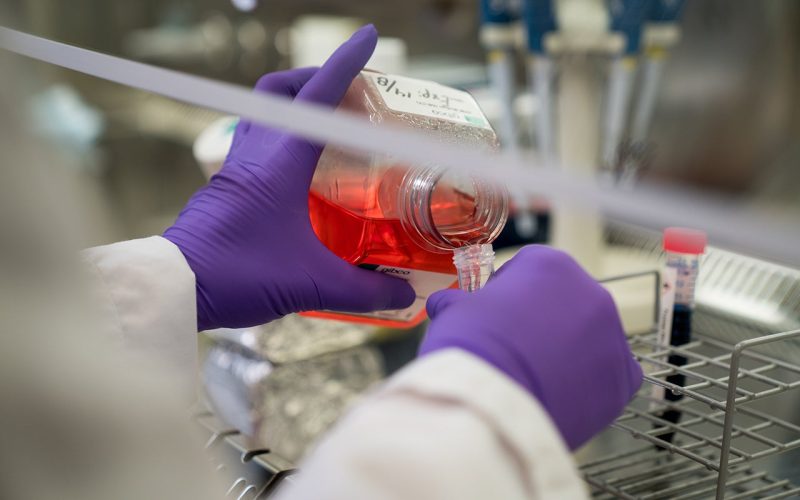For her PhD research, investigator Zonne Hofman wanted to investigate the biochemical mechanisms behind hereditary angioedema. With the test she developed, a new inflammatory disease – FACAS – could be unraveled down to the protein level. And that offers opportunities for the treatment of patients with this sometimes life-threatening condition.
Hereditary angioedema is a rare condition that is accompanied by acute and often severe inflammatory reactions in the form of swellings (angioedema) of the skin and mucous membranes. The swellings occur in the face, arms and legs, throat and intestines. Angioedema in arms and legs has effects on ability to move and daily functioning. Swelling in the mucous membrane of the intestines often causes severe abdominal pain, possibly with vomiting and diarrhea. Swelling in the throat can make breathing difficult and can be life threatening.
A possible cause of hereditary angioedema is a defect in the DNA of the Factor XII gene. These patients produce too much of the protein bradykinin, leading to acute inflammatory reactions that cause swelling. In addition to switching bradykinin production on and off, the Factor XII gene has also an important role in blood coagulation. Patients with hereditary angioedema are therefore examined at UMC Utrecht at the Van Creveld Clinic, which specializes in coagulatory diseases. For the past two years, DNA testing can also be used to identify hereditary angioedema.
In her research, Zonne Hofman unraveled the mechanisms behind the disrupted bradykinin production in hereditary angioedema. “The tricky thing is that bradykinin is a small protein and is only present in the blood for a very short time: less than 10 seconds. Then it is broken down. That makes bradykinin hardly measurable,” she says. “Bradykinin, however, also has a precursor: kininogen. That substance is like a fingerprint of bradykinin and is present for much longer: a day or even longer. Kininogen is therefore easier to measure.” Hofman, together with researcher Coen Maas and colleagues, developed an ELISA test that focuses on measuring kininogen in blood plasma. When applied in hereditary angioedema, the test showed that kininogeen levels were increased. During acute inflammation and swelling, these were highest, but also at rest, more kininogen was found in patients compared to healthy people.
The research by Hofman and Maas took a special turn when in 2017 they had contact with colleagues from the Charité University Hospital in Berlin. They had a number of patients from one family with chronic complaints such as fever, skin rash and joint complaints that could not be explained. But they clearly had no swelling of the skin or mucous membranes. “Their chronic complaints fit with an auto-inflammatory syndrome, where the cause of the inflammatory response is not from the outside, but lies with the patient,” Maas said, “You would expect them to present rather at a rheumatology department than at a coagulation clinic.”
Because the complaints occurred with several family members, a hereditary disease was soon suspected. Extensive DNA testing with Whole Genome Sequencing found a new mutation of the Factor XII gene – just on a different part of the gene than the mutation associated with hereditary angioedema. With this, the Berlin researchers discovered together with colleagues at UMC Utrecht a new disease, which was named FACAS (Factor XII associated autoinflammatory syndrome). “Immediately afterwards we looked at protein level in a follow-up study in Utrecht to see how the disease works,” says Hofman. “In addition, we were able to use the new ELISA test.” At FACAS, bradykinin production was found to be disrupted. The conclusion is therefore that bradykinin also plays a role in inflammatory diseases other than hereditary angioedema. But there is a difference. With hereditary angioedema, the values are sometimes too high and these people are otherwise healthy. This is very different in patients with FACAS: in these, bradykinin production is constantly increased, as a result of which they suffer from a chronic inflammatory disease with rheumatic symptoms.
The researchers decided to replicate the Factor-XII protein in the laboratory, with the same DNA error as in FACAS patients. “Factor XII is always present in the blood, but usually inactive. Otherwise you would continuous produce bradykinin and that is enormously harmful, if not life-threatening,” says Maas. When copying Factor XII with the DNA error, the protein became active immediately. It also remained active – resulting in constant disruption of bradykinin production.
What does this imply for treatment options? In patients with hereditary angioedema, giving a bradykinin receptor antagonist helps to block the activity of bradykinin. “We also tested that medicine in some patients with FACAS, but unfortunately it did not work for all,” says Hofman. “It is important that we now know the cause of FACAS. This makes it possible to detect the disease in families where these symptoms occur. The next step is to develop medication to prevent people with FACAS from developing a chronic inflammatory disease.”
Hofman, Maas and colleagues wrote three articles as a result of this research, which will be published soon in Nature Communications, Journal of Biological Chemistry and in Thrombosis and Haemostasis. “That is exceptional,” Maas knows. “In two years we have gone from human to molecule to possible treatment. That is very fast for scientific research.” In addition, there has been international collaboration and the researchers have also constantly crossed the boundaries between medical specialties such as immunology, hematology, cardiovascular diseases, but also between laboratory, biobank, DNA research and drug studies. “We have not kept to the traditional silo’s,” says Maas. “After all, with complaints from hereditary angioedema or FACAS, a patient can enter the hospital through different entrances: via the emergency department, dermatology, rheumatology or cardiology. These diseases do not fit in one box.”
